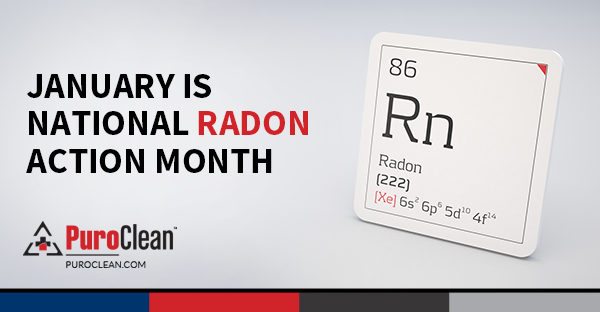 National Radon Action Month is here! Radon is an odorless, colorless, and tasteless radioactive gas found in rock, soil, and water, and is relatively harmless outdoors. It can enter homes and buildings through cracks and holes in the foundation, becoming trapped and building up which creates a health hazard. When you inhale radon, you are exposed to it. Elevated levels of radon can be present in various places like workplaces, schools, or any structure. Since you spend the majority of your time at home, that is where exposure to radon is most probable. It is the leading cause of lung cancer among nonsmokers and claims the lives of around 21,000 Americans yearly.
National Radon Action Month is here! Radon is an odorless, colorless, and tasteless radioactive gas found in rock, soil, and water, and is relatively harmless outdoors. It can enter homes and buildings through cracks and holes in the foundation, becoming trapped and building up which creates a health hazard. When you inhale radon, you are exposed to it. Elevated levels of radon can be present in various places like workplaces, schools, or any structure. Since you spend the majority of your time at home, that is where exposure to radon is most probable. It is the leading cause of lung cancer among nonsmokers and claims the lives of around 21,000 Americans yearly.

Table of Contents
History Of Radon
In the late 1980s, naturally occurring radon gas was identified as a potential health risk. This gas, produced by the radioactive decay of uranium in minerals like granite, has the ability to seep through soil and rocks. It can enter buildings through basements due to its higher density than air and through water sources from wells because it is soluble in water. Poorly ventilated houses can accumulate this gas. The decay of radon creates radioactive by-products (polonium, bismuth, and lead isotopes) that can be ingested through well water or inhaled after attaching to dust particles.
Prolonged exposure to elevated levels the gas and its byproducts can significantly raise the chances of developing lung cancer. In fact, radon is currently believed to be the primary cause of lung cancer among nonsmokers in the United States. Homes constructed above geological formations with uranium mineral deposits tend to have the highest radon levels.
National Radon Action Month

January 2017 is National Radon Action Month sponsored by the United States Environmental Protection Agency (EPA). The goal of National Radon Action Month is to increase public awareness, encourage radon testing and mitigation, and promote the use of radon-resistant construction techniques.
During this month, you are encouraged to test your home using a simple radon testing kit. You can find more information about test kits here. Another option is to hire a qualified testing or mitigation contractor in your area to professionally perform the test.
If you are in the market for a new home, the EPA advises that you look for a radon-resistant one. Check out these companies that use radon-resistant construction techniques.
Furthermore, you can help spread the word about the dangers of radon by participating in special events and activities in your community. Contact your municipality or county to learn about local events. EPA’s website provides a variety of information and materials to help you plan and implement your own radon outreach activities.
Spread the word, get involved, and be part of the national effort to reduce radon exposure!



 PuroClean Home Emergency Services
PuroClean Home Emergency Services